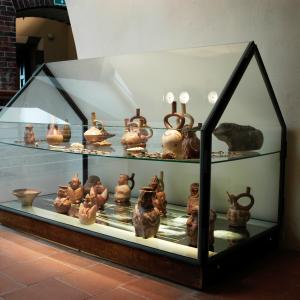Moche Civilization (100-750 A.D.)
The Moche Civilization flourished on the northern coast of ancient Peru, along the Moche river valley. The Moche society was made up of an élite class – consisting of priests, healers, soldiers, administrators and governors – and of a lower class – consisting of farmers, fishers, artisans and builders. The Moche erected imposing buildings using sun-dried clay bricks (adobe), terraced pyramidal temples such as the Huaca del Sol and Huaca de la Luna, and realized great hydraulic works. Their economy was based on fishing and agriculture. An important role was played by blacksmiths and potters, who produced the typical orange and cream coloured vessels. The most common vessel shapes include stirrup-vases, portrait-vases, figurative vases with anthropomorphic, zoomorphic, animal and plant representations, and vases with painted life-scenes. Extremely naturalistic, Moche ceramics document everyday life, hunting and war scenes, and depict various myths and figures of lords, priests, warriors and prisoners, thus providing an interesting illustration of Moche daily life.
Anthropomorphic molded figure representing a male character standing with headgear, pendants and two-wire necklace

Anthropomorphic molded figure representing a male character standing with headgear, pendants and two-wire necklace
Anthropomorphic molded figure representing a male character standing with headgear, pendants and two-wire necklace

Anthropomorphic molded figure representing a male character standing with headgear, pendants and two-wire necklace
Necklace made of stone, coral, shell

Necklace made of stone, coral, shell
Necklace made of stone, coral, shell

Necklace made of stone, coral, shell
Spondylus shells

Spondylus shells
Spondylus shells

Spondylus shells
Flutes

Flutes
Flutes

Flutes
Vase with a bridge shaped handle representing the head of a jaguar

Vase with a bridge shaped handle representing the head of a jaguar

Vase with a bridge shaped handle representing the head of a jaguar

Vase with a bridge shaped handle representing the head of a jaguar

Area Moche

Area Moche

Area Moche

Area Moche





